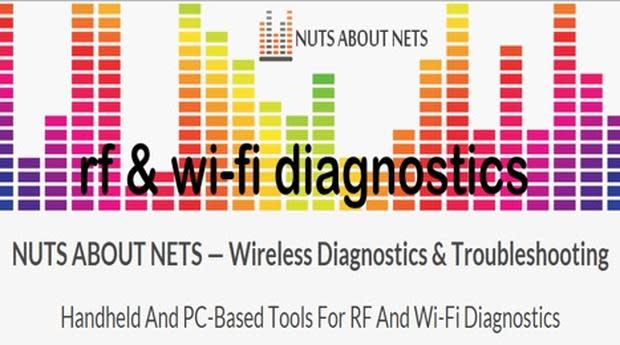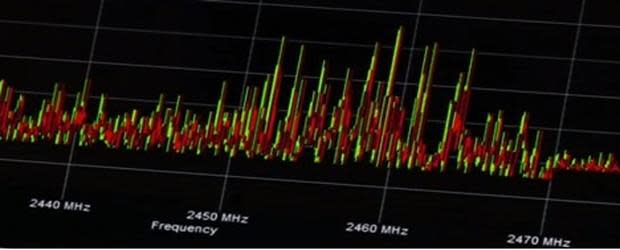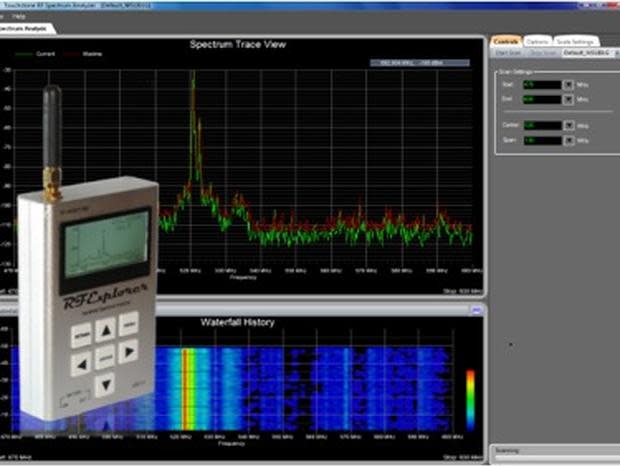RF Explorer: A good, inexpensive RF spectrum analyzer

Figure A
Image: Nuts About Nets
For Wi-Fi analysis tools, my go-to-person is Nuts About Nets owner Steve Leytus. Nuts About Nets offers tools that measure Radio Frequency (RF) characteristics, ranging from network discovery to spectrum analysis. This post and this post look at some of the tools tendered by the company.
Wi-Fi tech wish list

Image: Nuts About Nets
One tool that many Wi-Fi techs have on their wish list is an RF spectrum analyzer. That's because when tasked with tracking down an RF interference problem like that shown in Figure B, other than guessing, using an RF spectrum analyzer is the only way to determine the source and exact frequency of the interference. However, good RF spectrum analyzers are expensive.
A good and inexpensive RF spectrum analyzer
One reason Nuts About Nets is interesting is the company's ability to offer great tools (software and hardware) that are inexpensive. And, it appears Leytus has done it again with his newest offering: RF Explorer, a low-cost spectrum analyzer. The Wi-Fi version is less than $120. "RF Explorer is a remarkable device -- and it would belittle its true value to even qualify that statement by saying for the money," mentions Leytus. "Performance and sensitivity are on par with instruments that cost many times more."
Figure C

Image: Nuts About Nets
RF Explorer (Figure C) is the design of Ariel Rocholl and his team of engineers in Spain, manufactured by Seeed Technology in China, and distributed by Nuts About Nets. This YouTube video explores the screens on the hand unit. RF Explorer also operates with a PC. The PC app, also shown above, is the product of Nuts About Nets.
See the full list of features and specifications. Some of the more notable features are:
Spectrum Analyzer modes: Peak Max, Normal, and Averaging.
Supports frequencies from 15 to 2,700 MHz, including sub-1 GHz ISM bands and 2.4 GHz ISM band (Bluetooth, Wi-Fi, ZigBee, etc.). In early 2015, a dual-band device supporting both the 2.4 GHz and 5.0 GHz ISM bands will be available.
Integrated RF Signal Generator for the ISM band of choice in a subset of models.
Lifetime free firmware upgrades available, open to community-requested features.
High-capacity battery for 16 plus hours of continuous run, rechargeable by USB.
Windows PC client.
Internal expansion port for optional extensions with RF Explorer Expansion Modules.
For Wi-Fi techs, here are the specs:
Dynamic range: -115 dBm to 0 dBm (depends on the model)
Absolute Max input power: +5 dBm
Average noise level (typical): -115 dBm (depends on the model)
RF generator amplitude: -30 dBm to 21 dBm (depends on the model)
Included matched and calibrated antenna
Frequency stability and accuracy (typical): +-10 ppm
Amplitude stability and accuracy (typical): +-3 dBm`
Frequency resolution: 1 Khz
Frequency span: 112 KHz - 600MHz (depends on the model)
Resolution bandwidth (RBW): automatic 2.6 Khz to 800 Khz (depends on the model)
Weight: 185 grams
Size: 113x70x25 mm
More goodies for those who like to dig inside the hardware and software:
Windows PC Client source code: Developed in C# and Visual Studio 2010, you can customize it for your own needs under the GPL license.
RS232 - USB protocol specification: Full documentation to interface RF Explorer with any RS232 capable software or operating system. The limit here is the CP2102 USB driver, now supported in Windows, Linux, and Mac OS by Silicon Labs.
RF Explorer circuit schematic: RF Explorer is based on the microchip PIC24FJ64GA004 16 bits MCU along with a Silicon Labs Si4432 transceiver.
A standalone RF spectrum analyzer that also connects to a PC running more graphical diagnostic software is unique in the wireless industry. Rocholl adds, "Some library licensing limitations prevent us from opening RF Explorer native firmware as open source, however we will offer a fully open Arduino compatible internal expansion module so you can complement, extend or even override original firmware with your own."
One of the first things I did when I met Leytus was ask about the name Nuts About Nets. Leytus a Biochemistry PhD with a BS in Computer Science answers, "We wanted a name that conveyed what we do (the "Nets" part) and that we enjoy it (the "Nuts about" part). The world is full of serious issues -- troubleshooting Wi-Fi networks should not be one of them."

